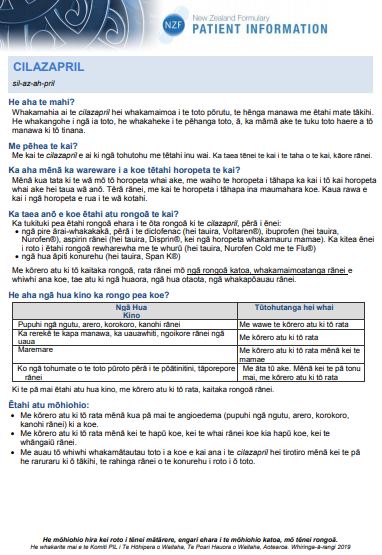Cilazapril
Sounds like 'sil-az-ah-pril'
Key points about cilazapril
- Cilazapril is used to treat high blood pressure and heart failure and to prevent kidney problems in people with diabetes.
- Cilazapril is also called Zapril.
- Find out how to take it safely and possible side effects.

Cilazapril has many different effects on the body and is used to treat a variety of conditions. It belongs to a group of medicines called ACE inhibitors. Cilazapril may be used for:
- high blood pressure by relaxing and widening your blood vessels and lowering your blood pressure
- heart failure to help your heart pump blood more easily – this can help to relieve symptoms such as shortness of breath and swelling in your feet, legs and abdomen (tummy)
- diabetic kidney disease (diabetic nephropathy) to protect your kidneys and help them to function.
Cilazapril can work quickly for hypertension (high blood pressure). If you have heart failure it may be a few weeks before you notice an improvement in your symptoms.
2024: Notification that cilazapril is being discontinued in New ZealandCilazapril is used in New Zealand much more than any other country. There's only one factory making cilazapril in the world, which puts New Zealand at risk if a future supply issue arises. To reduce the risk, Pharmac (our medicine funding agency) are asking people to move away from using cilazapril. Based on current demand, the remaining stock of the cilazapril 5 mg tablets in New Zealand is expected to be exhausted by November 2024. Stocks of 0.5 mg and 2.5 mg tablets will expire in October 2024. If you haven't already, talk to your healthcare provider about changing your medicine. |
In Aotearoa New Zealand cilazapril is available as tablets (500 micrograms, 1 mg, 2.5 mg and 5 mg).
- The dose of cilazapril will be different for different people depending on your condition.
- Your doctor will usually start you on a low dose so it doesn't make you feel dizzy. Your dose will be increased slowly over a few weeks depending on how you respond. This allows your body to get used to the medicine and reduces side effects.
- Always take your cilazapril exactly as your doctor has told you. The pharmacy label on your medicine will tell you how much cilazapril to take, how often to take it and any special instructions.
- Check with your pharmacist if your tablets are different to what you expect.
- Timing: Cilazapril is usually taken once a day. Take your cilazapril dose at the same time each day. It's best taken in the morning. You can take cilazapril with or without food.
- Limit alcohol intake while you are taking cilazapril: Alcohol can increase your chance of side effects (eg, dizziness and light-headedness).
- Missed dose: If you forget to take your dose, take it as soon as you remember. But if it's nearly time for your next dose, just take the next dose at the right time. Don't take double the dose.
Cilazapril is not suitable if you're pregnant or planning a pregnancy. It's also not suitable if you've had a severe allergic reaction to an ACE inhibitor in the past, eg, swelling of your lips, eyes or tongue (called angioedema). Read more about who cannot take ACE inhibitors. If you're already taking diuretics (water pills), your doctor will monitor you very closely when you first start taking cilazapril.
Here are some things to know when you're taking cilazapril. Other things may be important as well, so ask your healthcare provider what you should know about.
Monitoring
Your doctor will arrange for you to have blood tests and blood pressure checks before you start taking cilazapril and during your treatment, especially when you first start taking it. This is to check how it's working and to check your kidneys and potassium levels.
Have a sick day plan
If you have diarrhoea (runny poo) or are vomiting (being sick) from a stomach bug, or are dehydrated from another illness, it’s important to let your healthcare provider know. They may advise you to stop taking your cilazapril for a few days, or decrease the dose and start again when you feel better.
Be careful when taking some pain relief medicines
ACE inhibitors can be used to protect your kidneys from damage if you have diabetes. However, if you're taking cilazapril and diuretics (water pills), the combination of these with NSAIDs (anti-inflammatory pain relief medication) can be very harmful to your kidneys. It can cause acute kidney injury. This combination is called the 'dangerous trio' or 'triple whammy'. You have a higher risk of harm to your kidneys if you're also an older adult (over 65 years) or you're dehydrated.
If you're taking an ACE inhibitor with a diuretic, do not use NSAIDs for pain relief. Ask your doctor or pharmacist for a safer option. Read more about NSAIDs and protecting your kidneys.
| Examples of diuretics | Examples of NSAIDs |
|
|
Like all medicines cilazapril can cause side effects, although not everyone gets them. Often side effects improve as your body gets used to the new medicine.
| Side effects | What should I do? |
|---|---|
|
|
|
|
|
|
|
|
|
|
Read more about medicines and side effects and reporting a reaction you think might be a side effect.
The following links provide more information on cilazapril.
Cilazapril(external link) New Zealand Formulary Patient Information te reo Māori(external link)
Zapril(external link) (external link) Medsafe Consumer Information
References
- Cilazapril(external link) New Zealand Formulary
Changing ACEs – The new line up(external link) He Ako Hiringa, NZ, 2022
Prescribing ACE inhibitors: time to reconsider old habits(external link) BPAC, NZ, 2021
Cilazapril unplugged – what alternatives?(external link) He Ako Hiringa, NZ, 2021
Hypertension and heart failure(external link) NZ Formulary, NZ, 2024
Brochures


Medicines and side effects
Healthify He Puna Waiora, NZ, 2024

Health Quality and Safety Commission, NZ, 2019
English, te reo MāoriCredits: Sandra Ponen, Pharmacist, Healthify He Puna Waiora. Healthify is brought to you by Health Navigator Charitable Trust.
Reviewed by: Angela Lambie, Pharmacist, Auckland
Last reviewed:
Page last updated:





